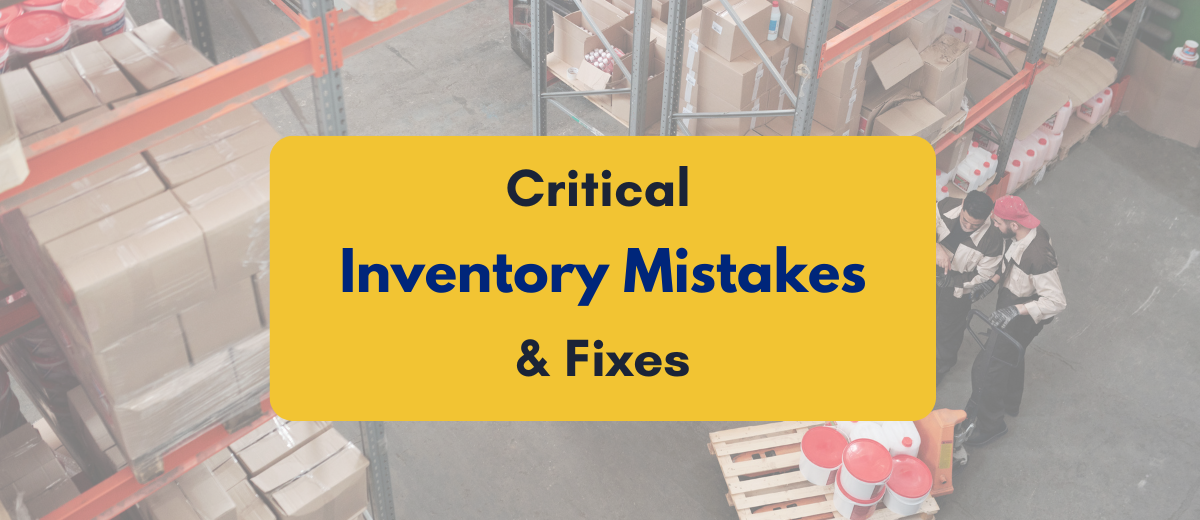Inventory management is the lifeblood of any product-based business. Whether you’re running a small retail store, an e-commerce brand, or a manufacturing company, how you handle your inventory directly affects your bottom line.
Yet, many businesses—big and small—make critical mistakes in managing their stock, leading to inefficiencies, cash flow problems, and missed sales opportunities.
In this blog, we’ll dive into the top 7 inventory mistakes that could be draining your profits—and how to fix them.
1. Overstocking: The Costly Comfort Zone
Many businesses fall into the trap of overstocking because they fear running out of products.
While it may feel safer to have more than enough, the reality is that excess inventory ties up your working capital.
Not only does it take up physical space, but unsold inventory can also become obsolete, especially in industries with trends or perishables.
Why it’s costing you money:
- Increases warehousing costs
- Higher risk of spoilage or obsolescence
- Ties up cash that could be used elsewhere
Fix it: Use demand forecasting tools based on historical data, sales trends, and market conditions. Implement inventory systems with automatic reorder points and consider lean inventory methods like Just-In-Time (JIT) to reduce waste.
2. Understocking: Missing Sales Opportunities
On the flip side, understocking is equally damaging. When you don’t have enough product to meet demand, customers are likely to turn to competitors—possibly for good.
Why it’s costing you money:
- Lost sales and damaged customer loyalty
- Lower customer satisfaction
- Emergency restocking can cost more
Fix it: Track your sales velocity and set minimum inventory thresholds. Use automated reorder systems to ensure you’re replenishing stock based on real-time sales data. Don’t forget to account for seasonal demand and promotions.
3. Lack of Inventory Visibility
Do you know what’s in your warehouse right now? If you don’t have real-time visibility into your inventory, you’re flying blind.
Disconnected systems, manual spreadsheets, or inconsistent reporting can lead to inaccurate stock levels and poor decision-making.
Why it’s costing you money:
- Increases human error
- Leads to double ordering or missed reorders
- Inaccurate reporting distorts business insights
Fix it: Invest in cloud-based inventory management systems that integrate with your POS, e-commerce, and accounting platforms. Real-time visibility ensures your team is always working with up-to-date data, preventing errors and improving decision-making.
4. Ignoring Inventory Turnover Rates
Inventory turnover measures how quickly you sell and replace stock within a specific period.
A low turnover rate indicates overstocking or slow-moving products, while a high rate could signal understocking or strong demand.
Why it’s costing you money:
- Low turnover = tied-up capital and dead stock
- High turnover without proper planning = missed sales
Fix it: Calculate your turnover rate by SKU or category. Identify slow-moving products and create strategies to sell them (e.g., bundles, discounts). Focus on your high-turnover products and streamline restocking to keep them available.
5. Poor Demand Forecasting
Relying solely on gut feeling or last year’s numbers for forecasting can backfire.
Without data-driven insights, businesses either overestimate demand (leading to overstocking) or underestimate it (causing understocking).
Why it’s costing you money:
- Mismatched supply and demand
- Stockouts during peak season
- Excess inventory during slow periods
Fix it: Use data-driven forecasting tools that account for historical sales, seasonality, marketing campaigns, and external factors like economic conditions or competitor activity. Advanced inventory platforms even use AI to predict demand more accurately.
6. Inefficient Warehouse Organization
How your inventory is stored has a direct impact on operational efficiency. Poor warehouse layouts, disorganized shelving, or lack of labeling can cause picking errors and slow down order fulfillment.
Why it’s costing you money:
- Increases labor time and costs
- Delays in shipping and fulfillment
- Higher rate of order errors
Mend: Implement warehouse best practices like:
- ABC analysis (prioritize high-value items)
- Barcode or RFID tracking
- Logical layout based on picking frequency
Consider warehouse automation or using a warehouse management system (WMS) to streamline operations further.
7. Neglecting Regular Audits and Reconciliations
One of the most overlooked aspects of inventory management is verifying that what your system says you have matches what’s actually in your warehouse.
Inventory shrinkage—whether due to theft, damage, or administrative errors—can seriously eat into your profits if you’re not performing regular audits.
Many businesses assume their records are accurate, only to find significant discrepancies when it’s too late.
Why it’s costing you money:
- Inventory losses go undetected
- Financial reports become unreliable
- Compliance issues with regulators or auditors
Mend: Schedule periodic cycle counts and annual physical inventory audits. Reconcile differences immediately and identify the root causes to prevent recurrence. Integrate audits into your inventory management workflow.
Final Thoughts: Don’t Let Inventory Kill Your Profits
Inventory can be a silent profit killer when mismanaged. The good news? Every one of these mistakes is avoidable with the right strategy, tools, and processes.
Whether you’re a small business or a growing enterprise, fine-tuning your inventory practices will lead to better cash flow, higher customer satisfaction, and improved profitability.
Action Plan: Take Control of Your Inventory Today
Here are five practical steps you can take right now to eliminate costly inventory mistakes:
- Audit your current inventory processes. Identify where things are going wrong—stockouts, slow movers, inaccurate data, etc.
- Invest in a modern inventory management system. Cloud-based tools offer real-time visibility, automation, and integrations with your sales channels.
- Train your team on best practices. Your systems are only as good as the people using them. Make sure your staff understands procedures and responsibilities.
- Monitor your key metrics. Track inventory turnover, shrinkage, fulfillment accuracy, and reorder cycles regularly.
- Continuously improve. Inventory management is not a “set it and forget it” operation. Regularly review your strategy, adjust based on performance, and stay agile.
Mastering inventory management is not about perfection—it’s about consistency, visibility, and smart planning.
By addressing the seven mistakes outlined in this blog, you can significantly reduce waste, improve operational efficiency, and free up capital to invest in growth.
Eliminate the mistakes. Optimize the process. Watch your bottom line grow.

 Expert verified
Expert verified 

